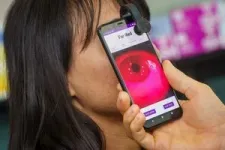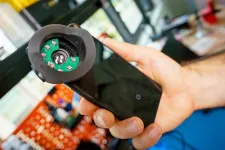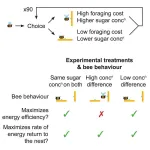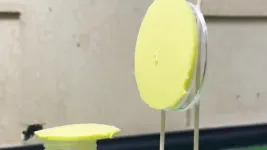(Press-News.org) Lingjia Liu, professor of electrical and computer engineering who is also an inaugural faculty member at the Virginia Tech Innovation Campus, has been awarded the Mobile Distributed Multiple-Input, Multiple-Output (Mobile dMIMO) project by the U.S. Department of Defense’s (DoD’s) Office of the Under Secretary of Defense for Research and Engineering (OUSD(R&E)) as part of its flagship FutureG program. The Mobile dMIMO project consists of three phases, with $9 million total planned funding — $1.5 million is for Phase 1 of the project. The Mobile dMIMO project represents one of the largest single awards received by a faculty member at the College of Engineering at Virginia Tech.
Through the award, Liu, the Bradley Senior Faculty Fellow in the College of Engineering and the director of Wireless@VT, will lead a team researching Mobile dMIMO-facilitated complex and large-scale wireless networks to help define and set the standards for FutureG technology.
Leading the push for FutureG
Virginia Tech already is leading the push into FutureG wireless technology through Wireless@Virginia Tech and the Innovation Campus in Alexandria, VA, set to open in 2024. Liu was awarded an $800,000 grant from the National Science Foundation (NSF) earlier this year to help create next generation (NextG) mobile broadband networks that increase the availability of access to users by providing seamless wireless coverage and supporting varying service requirements. This research is part of the NSF’s Resilient and Intelligent NextG Systems program, which combines resources and support from U.S government agencies such as the NSF, OUSD(R&E), and the National Institute of Standards and Technology (NIST), along with funding from major U.S.-based telecommunications companies such as Apple, Google, IBM, Nokia, and Microsoft.
The goal is to focus exclusively on NextG wireless, networking, and computing systems that may have potential impacts for the future of NextG standards. As the director of Wireless@Virginia Tech, Liu oversees a center of more than 30 faculty that already focus on research and development in wireless communication and networking.
“If we can develop and demo the technology, we have a very good chance of achieving many features of 6G,” said Liu. “Furthermore, we anticipate making technical contributions to 3GPP, which is the standard body set to define the technical specifications for 6G and beyond standards. If so, we would literally be contributing to the 6G standards and would be defining what 6G is. Virginia Tech would help to drive the standardization specifications, which is extremely rare for an academic institution to have the opportunity to do so.”
The OUSD(R&E) FutureG program aims to accelerate the adoption of new wireless networking technologies to ensure that DoD military forces can operate effectively anywhere.
Since coming to Virginia Tech in 2017, Liu has been “a tremendous asset and force in the department. His work on 6G networks and machine learning for wireless is highly topical right now,” said Luke Lester, the Roanoke Electric Steel Professor and head of the Bradley Department of Electrical and Computer Engineering. “This comprehensive 6G initiative will represent pioneering research and impressive teaching opportunities in connecting massive traditional terrestrial fiber networks wirelessly using MIMO. I have no doubt he will lead his team to success in this critically important project.”
Scope of work
MIMO is an antenna technology for wireless communications in which multiple antennas are used at both the source, or transmitter, and the destination, or receiver. The antennas at each end of the communication circuit are combined to minimize errors, optimize data speed, and improve the capacity of radio transmissions by enabling data to travel over many signal paths at the same time using varied broadband messaging.
MIMO is the enabling technology for 4G LTE-Advanced. Its extended version, called massive MIMO, is the enabling technology for 5G new radio systems. Traditionally, MIMO antennas are co-located, such as at a base station. For this project, Liu and his team will work to bring MIMO technology to the next level, leveraging mobile distributed MIMO networks where distributed antenna arrays are wirelessly connected.
Distributed MIMO has multiple advantages over its co-located counterparts:
Improved coverage: Distributed MIMO can utilize multiple antennas that are spread out over a larger geographical area, covering a larger space.
Improved scalability: Because antennas in distributed MIMO are not co-located at the base station, they circumvent the form factor limitation at the base station to improve the scalability of the number of antennas utilized in the system.
Reduced interference: In co-located MIMO, antennas are deployed at the base station, which can sometimes interfere with each other’s signals. Distributed MIMO spreads antennas geographically, reducing this interference.
Enhanced reliability: With antennas deployed in different locations, distributed MIMO can provide more reliable connections to users irrespective of their geolocations. It's like having multiple pathways to walk from a starting point to the destination. If one path has obstacles, you can choose another path to reach your destination.
Future impact of mobile distributed MIMO networks
Designing mobile distributed MIMO networks is complicated and challenging, but the work is expected to result in applications that unlock technologies for 6G and beyond. These include
Commercial communications: 6G is expected to provide higher data rates with more reliable services.
Reduced operating expenses: Mobile distributed MIMO networks use wireless connections instead of fiber, meaning it operates with less costly infrastructure.
Military communications: 6G could dramatically improve situational awareness and decision-making for military operations and shorter conflicts. Wireless connections are more agile and could be set up and dismantled quickly in the field.
Improved location services: 6G is expected to detect locations accurately within centimeters, meaning drones or other unmanned vehicles could be sent into dangerous environments without risking human lives.
Cybersecurity: 6G would incorporate advanced security features to minimize or eliminate cyberattacks. By distributing antennas in various locations, mobile distributed MIMO networks avoid the common issue of single point of failure.
As the initiative develops, additional opportunities and applications will become “real and relevant for FutureG,” said Liu. “Harnessing wireless technology through mobile distributed MIMO networks means developing an enabling technology that has so far been unrealized or imperfect at best. It will have profound impacts for FutureG networks.”
According to industry experts, the 6G network is expected to be 100 times faster than the current 5G network, offering data speeds of up to 1 terabyte per second. 6G networks will be able to use higher frequencies than 5G networks and provide faster response times without delays or lags.
Teamwork is key
According to Liu, collaboration and teamwork will be critical to the effort. Not only are the Office of the Under Secretary of Defense for Research and Engineering and Lockheed Martin Advanced Technology Laboratories involved as partners, but various organizations across the university — including Wireless@Virginia Tech, the Bradley Department of Electrical and Computer Engineering, the Virginia Tech National Security Institute, the Innovation Campus, and Commonwealth Cyber Initiative Southwest Virginia – are also involved.
The research team led by Liu includes electrical and computer engineering Professors Mike Buehrer, Jeff Reed, Nishith Tripathi, and Yang “Cindy” Yi as well as Daniel Jakubisin from the National Security Institute, who will serve as the deputy co-principal investigator for the project award.
Lockheed Martin Advanced Technology Laboratories will serve as a subcontractor to assist the team on transition and field demonstration.
“This is a true team effort,” Liu said. “It’s not ever just one person leading the charge, but rather multiple smart and talented stakeholders who collaborate to make the breakthrough discoveries that change the status quo. It’s wonderful to watch and exceptionally rewarding to be part of this type of a team.”
As an academic institution, Virginia Tech’s primary goal is to teach students, a role Liu prioritizes. Over the course of the award period, numerous Virginia Tech graduate students will have the opportunity to support the research.
“We conduct fundamental theoretical analysis and design the prototypes,” Liu said. “And we teach future professionals how to apply what we discover in the real world. We are quite literally building a pipeline of talent to industry, academia, and to the government. The students will learn by doing, and we simultaneously lay the foundation for future career professionals who will go on to make a real, true, meaningful difference in the world.”
END
$9 million award from the Department of Defense will fund groundbreaking FutureG research
Lingjia Liu will lead a crossdisciplinary team in researching large-scale wireless networks for FutureG technology.
2023-10-24
ELSE PRESS RELEASES FROM THIS DATE:
Smartphone attachment could increase racial fairness in neurological screening
2023-10-24
Engineers at the University of California San Diego have developed a smartphone attachment that could enable people to screen for a variety of neurological conditions, such as Alzheimer’s disease and traumatic brain injury, at low cost—and do so accurately regardless of their skin tone.
The technology, published in Scientific Reports, has the potential to improve the equity and accessibility of neurological screening procedures while making them widely available on all smartphone models.
The attachment fits over a smartphone’s camera and improves its ...
New methods for effective transport of large genes in gene therapy
2023-10-24
Gene therapy currently represents the most promising approach for the treatment of hereditary diseases. Yet despite significant breakthroughs in recent years, there are still a number of hurdles that hinder the wider application of gene therapies. These include the efficient delivery of genetic material into target cells with minimal side effects using adeno-associated viral vectors (AAVs). The AAV carrier substances have an advantageous safety profile and high gene transfer efficiency, meaning they are often used in gene therapies and in gene editing with CRISPR/Cas. But, AAVs have limited DNA uptake capacity ...
New tool may flag signs of pandemic-related anxiety and depression in healthcare workers
2023-10-24
An artificial intelligence tool effectively detected distress in hospital workers’ conversations with their therapists early in the pandemic, a new study shows, suggesting a potential new technology that screens for depression and anxiety.
As the coronavirus pandemic forced many hospitals to operate beyond capacity, medical workers faced overwhelming numbers of work shifts, limited rest, and increased risk of COVID-19 infection. At the same time, quarantine policies and fear of infecting family reduced their ...
Bumblebees visit flowers with more difficult-to-access nectar for immediate benefit to the colony
2023-10-24
If you’ve ever watched a bumblebee move from flower to flower, you might wonder how they decide which flower to choose and how long to stay. Now, researchers reporting in the journal iScience on October 24 have new insight based on their observations of bumblebees’ interactions with slippery artificial flowers. They found that the bumblebees make choices to maximize the rate of energy return, or the amount of sugar collected each minute.
“Bumblebees can make decisions ‘on the fly’ about which nectar sources are the most energetically economical,” said Jonathan ...
Making chemistry more accessible at the University of Oxford by providing period products
2023-10-24
When it comes to the question of who gets to be a scientist, gender disparities are well-documented in many fields. Patching the infamous “leaky pipeline” can be a thorny problem, but during the 2022–2023 school year, the Department of Chemistry at the University of Oxford took a simple and practical step forward: they began offering period products in the department’s bathrooms. In an article publishing October 25 in the journal Trends in Chemistry, three students involved in the Oxford Period Project and their supervising ...
Traditional chinese medicine compound (tongxinluo) and clinical outcomes of patients with acute myocardial infarction
2023-10-24
About The Study: In this randomized clinical trial of 3,777 patients with ST-segment elevation myocardial infarction (STEMI; a type of heart attack), the Chinese patent medicine Tongxinluo, as an adjunctive therapy in addition to STEMI guideline-directed treatments, significantly improved both 30-day and 1-year clinical outcomes. Further research is needed to determine the mechanism of action of Tongxinluo in STEMI.
Authors: Yuejin Yang, M.D., Ph.D., and Runlin Gao, M.D., of the Chinese Academy of Medical ...
Getting maximum calories in shortest time is the priority for bumblebees
2023-10-24
Research has found that bumblebees make foraging choices to collect the most sugar from flowers in the shortest time – even if that means using more energy in the process – to provide an immediate energy boost for the colony.
A new study investigating nectar drinking in one of the most common bumblebees in the UK, Bombus terrestris, has found that when foraging they maximise the amount of nectar sugar they take back to the colony each minute.
To make their choices, the bumblebees trade off the time they spend collecting nectar with the energy content of that nectar. This means ...
Incidence and transmission of SARS-CoV-2 in child care centers after COVID-19 vaccines
2023-10-24
About The Study: In this examination of SARS-CoV-2 incidence and transmission in child care centers (CCCs) and students’ households, transmission within CCCs and from children infected at CCCs into households was low in this study that included 83 children in 11 CCCs. These findings suggest that current testing and exclusion recommendations for SARS-CoV-2 in CCCs should be aligned with those for other respiratory viruses with similar morbidity and greater transmission to households.
Authors: Timothy R. Shope, ...
Neurodevelopmental outcomes among offspring exposed to corticosteroid and B2-adrenergic agonists in utero
2023-10-24
About The Study: The results of this study of 91,460 mother-offspring pairs found no association between in utero corticosteroid and β2-adrenergic agonist exposure and offspring neurodevelopmental outcomes, regardless of the timing of exposure. Despite the limitations and low power of the study, the findings suggest that corticosteroids and β2-adrenergic agonists are safe for pregnant individuals with asthma and the neurodevelopment of their offspring.
Authors: Abir Nagata, Ph.D., of Osaka University in Osaka, Japan, and Toshio Masumoto, Ph.D., of Tottori University ...
Child care centers unlikely source for COVID-19 transmission, study finds
2023-10-24
Children in child care centers are not spreading COVID-19 at significant rates to caregivers or other children at the center, nor to their households, according to a study led by University of Pittsburgh School of Medicine and UPMC Children’s Hospital of Pittsburgh pediatrician-scientists and published today in JAMA Network Open.
The findings suggest that recommendations to test symptomatic children for SARS-CoV-2, the virus that causes COVID-19, and keep positive children home from child care for prolonged periods can be revised to align with those for other serious ...
LAST 30 PRESS RELEASES:
Ice, ice, maybe: There’s always a thin layer of water on ice — or is there?
Machine learning lends a helping ‘hand’ to prosthetics
Noninvasive brain scanning could send signals to paralyzed limbs
Community water fluoridation and birth outcomes
SGLT2 inhibitors vs GLP-1 receptor agonists for kidney outcomes in individuals with type 2 diabetes
Long-term exposure to air pollution and risk and prognosis of motor neuron disease
Five-year absolute risk–based and age-based breast cancer screening in the US
Study finds elevated alcohol involvement in suicides of lesbian, gay and bisexual women
Air pollution may increase the risk of the neurodegenerative disease ALS
Chronic kidney disease poisons patients’ hearts, scientists discover
Hollings researchers reveal why some pancreatic tumors behave differently
DNA ties gut motility to vitamin B1
Study suggests pathway for life-sustaining conditions in Europa’s ocean
Researchers discover potential new target to treat Parkinson’s disease
Global societies unite to address environmental threats to heart health
Artificial light at night extends pollen season
Women see AI as riskier than men do
Push and pull in models of human migration
Mapping comedic timing, ta-da!
SEOULTECH researchers reveal strong public support for hydrogen fuel cell trucks
Dongguk University develops a new way to produce cheaper, more efficient green hydrogen
Scientists discover a hidden RNA “aging clock” in human sperm
New quantum boundary discovered: Spin size determines how the Kondo effect behaves
Ancient ‘spaghetti’ in dogs’ hearts reveals surprising origins of heartworm
Full value added tax on meat: a first step towards pricing the environmental damages caused by diets
Hidden mpox exposure detected in healthy Nigerian adults, revealing under-recognized transmission
Shingles vaccine linked to slower biological aging in older adults
A self-assembling shortcut to better organic solar cells
A two-week leap in breeding: Antarctic penguins’ striking climate adaptation
Climate risks to insurance and reinsurance of global supply chains
[Press-News.org] $9 million award from the Department of Defense will fund groundbreaking FutureG researchLingjia Liu will lead a crossdisciplinary team in researching large-scale wireless networks for FutureG technology.






